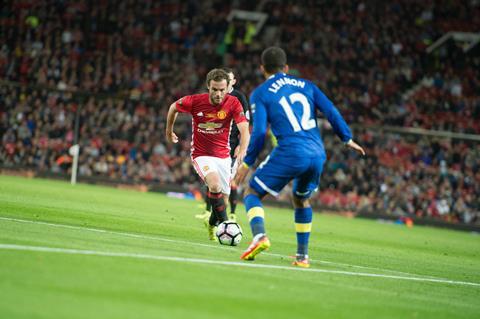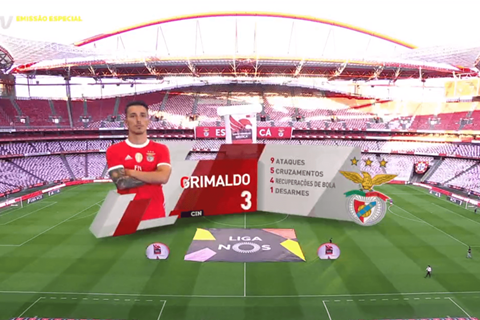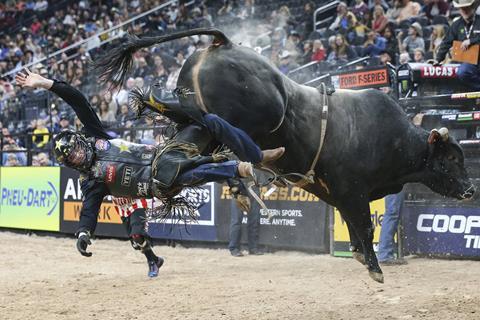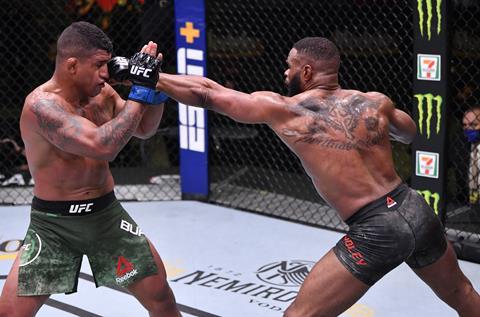How elite sports plan to social distance and get fans closer to the action after the coronavirus lockdown.

Four-year-old ‘Im Sophie’ was the unusual centre of a media scrum on Monday 01 June. The greyhound won the 10:21 at Perry Bar, the first race in the first professional sport in the UK to return following lockdown. Galvanised by the prospect of live sport, national press seized on the event in anticipation of greater things to come.
Elite sports have been given the nod to go live. Project restart is a major exercise in social distancing and leaner on-site workflows that has got every broadcaster and sports producer scrambling to adjust.
“In a nutshell I would say we’re looking at every single contract having a completely different production model post-COVID,” says Frank Callaghan, director of live programming and production at Gravity Media.
Sport is entering a period of uncertain duration in which competition is allowed to resume under strict biospheres. Sport teams aside, this includes continued restrictions on travel for production staff to and from hubs as well as fewer crew at venues.
Even then, a behind-closed-doors Formula 1 race is estimated to require around 1500 people, highlighting the scale of the logistics required to keep everyone safe.
When it resumes on June 17, the English Premier League will be more of a hybrid outside broadcast than it was when play ended in March. There’s no getting around the need for camera operators and technicians on site but the need to reduce footprints is imperative, says Nick Symes, Gravity’s technical director.
- Read more: 365 Playlist: Sport
Remote comes to the fore
Gravity Media’s soccer work ranges from producing world feeds of the EPL to acting as the BBC’s production partner for the FA Cup, which resumes quarter final action on June 27.
“The most pressing issue is how we operate from a gallery,” says Callaghan. “Normally you’d have a P.A, a director, EVS and graphics operator all in close proximity with a very fine-tuned workflow. Finding a way to bring back feeds to production centres, then add graphics and vision mixing desk with remote operators, possibly even doing commentary remotely. Nothing is off the table.”
Gravity has installed a remote talkback system enabling the team to produce greyhound and horse races by key staff working from home. It also operates postproduction and studio hubs in the UK and Australia meaning that it could mix an Aussie game in the UK – or vice versa – if necessary.
Remote production only goes so far. Mobile units are necessary for most live sport production and these are very cramped at the best of times.
“To overcome this, broadcasters can add extra units to provide greater spacing,” informs Glenn Adamo, managing director of The Switch Production Services. “They can also provide plexiglass partitions inside the truck and ensure all surfaces are sanitised before and after each show – as well as monitoring temperature readings to avoid the spread of the virus. Operators will have to certify that the air filters are highly efficient and changed regularly to capture particles. Headsets will have to be disinfected daily. Announcers could similarly be socially distanced in the announce booth.”
Substituting the crowd
Social distancing aside, it is empty stadia which is the main editorial concern. The lack of crowd colour, noise and ambience risks diminishing the broadcast product. Various innovations are likely to be introduced suited to different sports and dependent on clearing rights.
“This represents an opportunity for broadcasters to be novel and creative,” says Paolo Pescatore, tech, media & telco analyst at PP Foresight. “More replays and greater focus on players. Expect greater focus on the dug outs to hear what’s going on the behind the scenes. Some fans might even enjoy no atmosphere as they will be able to hear every kick, pass, shot and instructions from the bench. Switching commentators off should be an option.
“We might even see some cameras being operated remotely,” he predicts. “This could allow for more cameras to be onsite to provide different angles. However, there will be a supply issue given the number of matches that need to be completed for the current season.”
The German Bundesliga is the canary in the coalmine. As the first major European football league to resume following the epidemic, its behind closed doors trial has informed the EPL’s approach along with broadcasters BT Sport and Sky Sports (the BBC and Amazon).
The Bundesliga production is familiar but with significant tweaks. It chose to go live without crowd audio, although this proved so alien that local German stations and US distributors like ESPN added fake crowd noise.
Its directors framed the players at tighter angles to cut out empty stands and to capture more of the player’s emotional reaction as a substitute for crowd response. Close to the pitch cameras were repositioned to provide additional safety buffers.
All of these can be expected to crop up in the EPL’s reappearance.
Other possibilities including use of second screens to enhance the viewing experience “perhaps allowing fans to pick the angle close to where they are used to sitting in the ground,” speculates Callaghan. New sets of dynamic graphics and use of augmented reality is on the cards.

The AR³ Football software from WTVision is one product capable of generating virtual crowds as well as and tied-to-the-field augmented reality graphics like “man of the match” infographics. It is being used for resumption of the Portuguese Primeira Liga by broadcaster BTV.
A Danish league game on 25 May included a 40m x 3m screen in front of one stand filled with 10,000 fans watching by Zoom video link. Players could hear viewers in the virtual grandstand chanting.
Other ideas being discussed by the Premier League’s broadcast advisory group include integrating crowd noises from football sim game FIFA 20 into broadcasts, 360-degree replays, coaches and subs being interviewed live during match play and a new tactical camera feed.
“For sure there will be a bigger push towards social and immersive features at home,” Pescatore says. “This could include extended highlights, restart, in-game highlights. Who knows, maybe footballers and athletes will be the new broadcasters providing behind the scenes footage directly from their smartphones.”
With public viewing in pubs and bars currently closed, the in-home TV broadcast of matches is now all the more valuable for fans and broadcasters. Although customers paused their Sky Sports subscriptions during lockdown, this new opportunity gives Sky the chance to come out of the pandemic strongly.
According to Ampere analyst Daniel Harraghy, “As well as the chance to attract new subscribers, Sky will receive financial aid from the Premier League in the form of a rebate … expected to be worth £330m, shared between Sky and BT with the majority of this figure going to Sky.”
The benefits of being on site are tangible. Producers can instruct ENG crews to react very quickly to events, for example.
“With a disparate production team where comms are more lumpy, things inevitably take longer and that can effect production value if you don’t have the agility to react,” says Symes. “It has been a challenge since we’re all used to working in a certain way and expect to go into a gallery and sit next to the person pushing the buttons on the vision mixer or to shout at the EVS op. COVID-19 has deconstructed that thinking.”
He says, “Every production company and broadcaster is looking at what everyone else is doing in the market. It will be very fluid of the coming months. There is going to be a lot of trial and error.”

Bucking the trend
Professional Bull Riders (PBR), a subsidiary of IMG, was the first professional sport to return to competition in North America with a series of closed-to-fans event in Oklahoma beginning 25 April, then throughout May, broadcast on CBS Sports Network.
Production crew is approximately 20% fewer than pre-COVID. “There are fewer manned cameras, which means that a smaller crew is working harder and doing more things, with most everyone becoming a utility player,” explains Robby Greene, head of TV production for PBR.
Normally, a PBR event would have eight to nine manned cameras. To limit the number of crew it is using some robotic cameras and POVs. Additionally, outside the TV broadcast, two cameras are typically assigned to the in-arena production. Obviously, without fans in the arena viewing a Jumbotron, those cameras aren’t used, nor do they need the usual producer and director for the in-arena video production.
Crews have to follow PBR’s overall safety protocols. “They’re part of a working group, which must remain separated from other groups such as bull riders, bull stock contractors, judges and medical personnel,” Greene says.
At the Lazy E Arena in Oklahoma, PBR had 23 working groups. About half of these comprised the television broadcast.
“Within the working group, there is social distancing. All participants, including the crew, must be medically tested before they are allowed into the arena. We’re testing for both presence of virus and antibodies. Everyone is quarantined until testing negative for coronavirus, and then they can proceed in manning the production.”
The OB truck is a particularly protected bubble. “One half of the crew in the truck uses one door, the other half uses the other door,” he reports. “They’re all required to wear masks, which is a challenge with a headset on, but one we need to manage during this time.”
PBR doesn’t produce remotely. CBS play by play announcers and colour analyst are in the arena, socially distanced. Sideline interviews are done at a distance with boom mics.
“Events without fans have created a very different atmosphere,” he says. “It’s a lot more raw – fans can hear the clanging of metal gates and riders cheering for one another. At the three closed weekends in Oklahoma, we didn’t hide visuals of empty seats. Our opening shots showed the full arena, but during the bull riding, we did opt for tighter shots.”
For the upcoming PBR Monster Energy Team Challenge at the closed set at South Point Arena in Las Vegas (June 5-28), the team have created the Let ‘Er Buck Saloon in the Monster Pit, featuring LED boards and an array of speakers. Rather than fans seeing a backdrop of an abyss of empty seats, the video wall will carry a moving picture show of various graphic elements played to loud music.

Come out fighting
The Ultimate Fighting Championship (UFC) returned on 9 May live from VyStar Veterans Memorial Arena in Jacksonville, Florida. After three events, UFC returned to Las Vegas for a month-long series of matches hosted out of the UFC APEX facility. The events will be closed to fans and only essential event personnel will be in attendance with a number of increased health and safety measures in place including strict quarantine procedures leading up to the events.
Overall broadcast production personnel have been reduced by 40%. The announcers are seated at separate tables at least six feet apart. Other production personnel are required to wear PPE at all times. Plexiglas partitions have been installed in the production truck. Media interviews with fighters (both before and after the event) are conducted virtually.
“Events without fans have created a very different atmosphere,” he says. “It’s a lot more raw – fans can hear the clanging of metal gates and riders cheering for one another.” - Robby Greene, head of TV production for PBR
Essentially, all of the cameras used for normal fight coverage are being used except those used to capture crowd shots.
A UFC spokesperson explains: “There is an opportunity to enhance the broadcast on the audio side. Since a lot of the microphones that we use to capture the atmosphere aren’t capturing crowd noise, we’ll be able to focus solely on fight action inside the Octagon. The production team will look to incorporate not only the jolting blows during fight action but also the interactions between fighters and their corners.
“During the fight, you’re really going to hear those punches and kicks that are landing. When we’ve got 8,000 people in the stands, the viewer at home doesn’t always get the luxury of hearing exactly what it sounds like when a kick lands to the body. We’ll try to bring that sound into the broadcast more than we would in the past because we aren’t battling thousands of screaming fans. We will also be able to get very clean, clear audio from the fighters’ camps as they’re calling out instructions both during the fight and between rounds.”
Let’s go racing
Arena Racing Company (ARC) was the first pro sport to get back up and running in the UK. Gravity Media serves UK betting shops with feeds from ARC horse and greyhounds tracks and content to ARC’s international partners in Australia, Greece, the U.S and more.
Production was part-remote before the pandemic in that pictures from the track were relayed to a permanent production gallery housed at Gravity’s Chiswick-based production HQ. Facilities there include an EVS XT3 for feed ingest and replays, design and implementation of Aston 3D graphics with integration to live betting data, and dedicated audio capability.
The channel director, technical supervisor and EVS operator would normally be housed in the gallery with a commentator in adjacent voice-over booth. On resumption, all those key roles are being fulfilled remotely from home (with no EVS replays for the first couple of weeks back).
“We receive the video feeds into our MCR as normal [via NEP Connect which are managing social distancing at the track] with gallery operations stitched between production and managing the service output,” explains Nick Symes.
Gravity implemented remote access to MCR control systems and a low latency (half to one frame) streaming solution which provides each operator with a multi-view of feeds. Another video stream is used by the commentator, also working from home.



























No comments yet